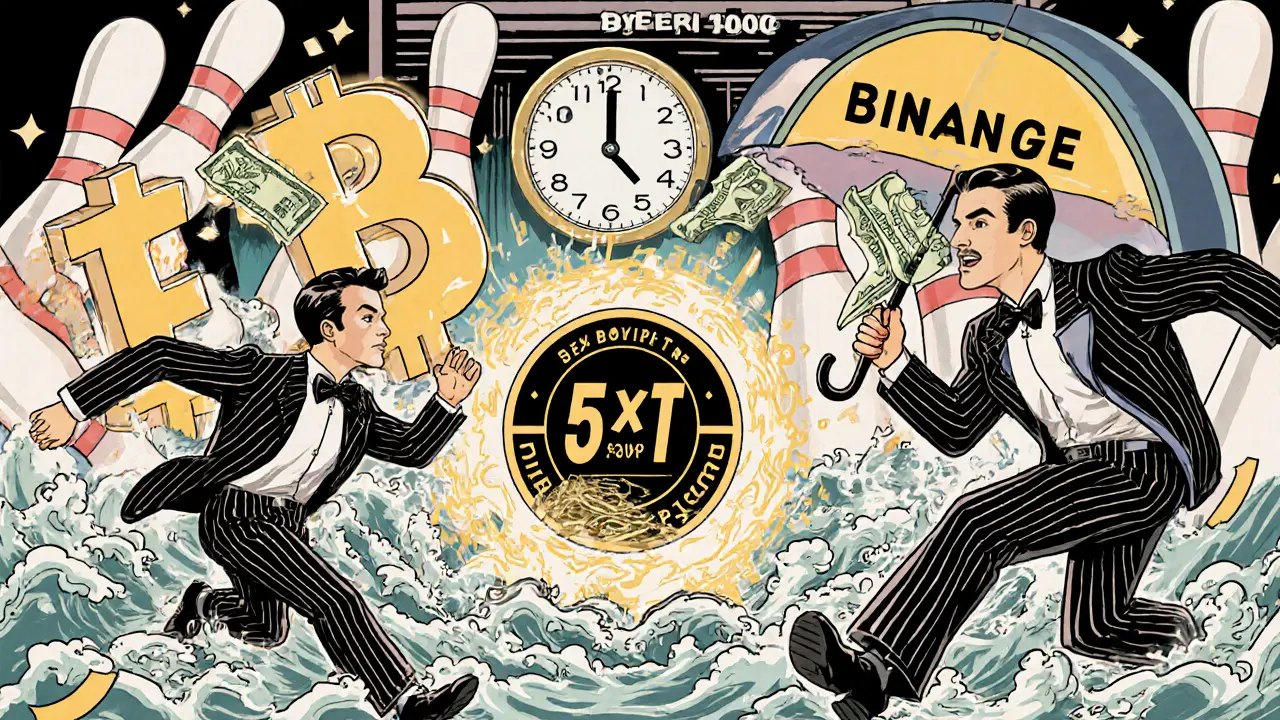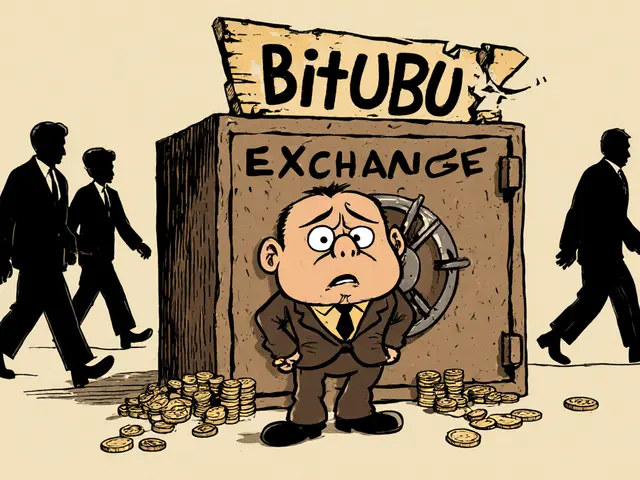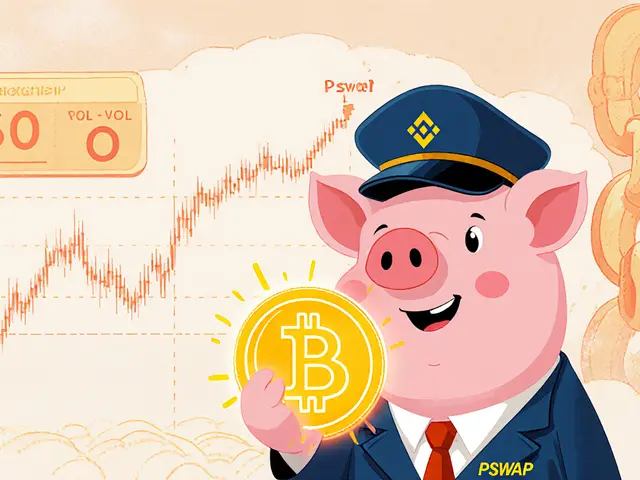
Margin Trading Calculator
Margin Trading Calculator
Margin Trading Results
Position Size: $0.00
Current Value: $0.00
Profit at 5% Gain: $0.00
Profit at 10% Gain: $0.00
Loss at 5% Drop: $0.00
Loss at 10% Drop: $0.00
Interest Cost: $0.00
Total Value After Interest: $0.00
Liquidation Price: $0.00
Margin Level: 0.00%
Important Risk Warning:
Margin trading can lead to losses exceeding your initial investment. Your account can go negative if the market moves sharply against you during liquidation.
When you trade crypto with margin, you’re not just betting on price movements-you’re betting with borrowed money. That means your wins can be bigger, but your losses? They can wipe out your account-and then some. In 2025, with crypto volatility still high and exchanges offering up to 100x leverage, margin trading isn’t just common-it’s dangerous if you don’t know what you’re doing.
How Margin Trading Works in Crypto
Margin trading lets you borrow funds from a crypto exchange to open a position larger than your account balance. If you have $1,000 and use 10x leverage, you can control $10,000 worth of Bitcoin. That sounds powerful. But here’s the catch: every 1% move against you now costs you $100, not $10. Your $1,000 isn’t just your investment-it’s your collateral.
Exchanges like Binance, Bybit, and Kraken allow you to borrow USDT or BTC to go long or short. The loan comes with interest, charged daily. Rates vary from 0.01% to 0.1% per day depending on demand. If you hold a position for a week, you’re paying up to 0.7% in interest alone-on top of slippage and fees.
There are two key numbers you need to know: initial margin and maintenance margin. Initial margin is how much you need to open the trade-say, 10% for 10x leverage. Maintenance margin is the minimum equity you must keep in your account to avoid being liquidated. Most exchanges set this at 2%-5%. If your account drops below that, your position gets automatically closed, often at a terrible price.
The Big Reward: Amplified Gains
Let’s say you buy 1 BTC at $60,000 using 5x leverage with $12,000 of your own money. If Bitcoin rises to $66,000-a 10% gain-you sell. Your position was worth $600,000. You repay the $480,000 you borrowed, and you’re left with $120,000. That’s a $108,000 profit on your $12,000 investment. That’s a 900% return.
That’s the dream. And it happens. Traders who catch a strong trend early, with solid risk controls, can turn small accounts into life-changing sums. In bull markets, margin traders often outperform cash holders by 3x to 10x. That’s why platforms like BitMEX and OKX built empires on leverage.
But here’s what no one tells you: that same 10% move down wipes out your entire stake. And if the market drops 20% in a day-like it did in May 2022 or June 2024-you’re not just losing your money. You’re owing the exchange.
The Hidden Danger: Unlimited Losses
Unlike buying Bitcoin outright, where your worst-case loss is 100%, margin trading can lose you more than you put in. If the market gaps down sharply-say, Bitcoin crashes from $60,000 to $50,000 in minutes-you might not have time to react. Your stop-loss doesn’t always trigger. Your liquidation price gets skipped. And suddenly, your account is negative.
That’s called a negative balance. And yes, exchanges can-and do-pursue you for the difference. In 2023, a trader in Singapore lost $180,000 on a short position after a sudden Fed announcement. His account went to -$45,000. He had to pay it back. That’s not rare. Reddit threads and Telegram groups are full of stories like this.
Margin calls are the silent killer. They don’t come with a warning email. They come with a liquidation. And when the market is panicking, everyone’s trying to exit at once. Prices crash. Liquidity vanishes. Your stop-loss becomes a market order. And you lose everything.

Why Most People Fail
Most people think margin trading is about predicting the market. It’s not. It’s about surviving the market.
Here’s what most beginners do wrong:
- They use 20x or 50x leverage on a coin with low volume. One tweet can kill them.
- They ignore interest costs and hold positions for weeks. That $1,000 position can bleed $50-$100 a month in fees.
- They don’t set personal stop-losses. They wait for the exchange’s liquidation level-which is too late.
- They trade without a plan. No entry, no exit, no risk limit.
According to data from CryptoCompare, over 85% of retail margin traders lose money within six months. The ones who survive? They treat margin like a scalpel, not a sledgehammer.
How to Trade Margin Safely
If you’re going to do this, here’s how to not end up on a Reddit thread titled “I lost my life savings.”
- Never use more than 5x leverage. Even 10x is risky. In crypto, 5x is enough to make good returns without risking bankruptcy.
- Only trade liquid assets. Bitcoin, Ethereum, Solana. Avoid memecoins or low-volume tokens. They can gap 30% in seconds.
- Set your own stop-loss 2-3% below your entry. Don’t wait for the exchange to do it. Use a limit order or a trusted bot.
- Keep 50%+ of your account in cash. If your margin position drops 10%, you need room to add funds or wait it out.
- Pay interest weekly. Letting it compound is like letting a small leak sink your boat.
- Never trade during major news events. FOMC, CPI, Bitcoin ETF decisions-these are minefields. Wait for the dust to settle.
Some traders use a “risk multiplier” rule: your potential loss should never exceed 2% of your total portfolio. So if you have $50,000, your max loss on any margin trade is $1,000. That’s how professionals think.

Margin vs. Futures vs. Spot
Not all leverage is the same.
| Method | Leverage | Liquidation Risk | Interest Cost | Best For |
|---|---|---|---|---|
| Spot Trading | 1x | None | None | Long-term holders |
| Margin Trading | 2x-10x | High | Daily | Active traders with experience |
| Futures (Perpetual) | 10x-125x | Very High | Funding rates (often negative) | Day traders, hedgers |
Futures have funding rates that can work for or against you. Margin trading has daily interest. Spot has no risk of liquidation. If you’re new, start with spot. If you’re experienced and want to scale, use margin-but only with strict rules.
Who Should Avoid Margin Trading
Margin trading is not for:
- People using money they can’t afford to lose
- Retirees or anyone relying on crypto for living expenses
- Traders who don’t track the market daily
- Those who don’t understand how liquidation works
- Anyone who thinks “it’ll bounce back”
There’s a reason big institutions like Fidelity and Vanguard only offer margin to accredited investors. They know most people don’t have the discipline, the knowledge, or the emotional control to handle it.
Final Reality Check
Margin trading isn’t a get-rich-quick scheme. It’s a high-skill, high-stress tool for people who treat it like a business-not a casino.
The rewards? Real. I’ve seen traders turn $5,000 into $50,000 in a bull run using 5x leverage and strict stops.
The risks? Catastrophic. I’ve seen the same people lose $50,000 in a week because they doubled down on a losing trade.
If you’re serious about margin trading, start small. Paper trade first. Learn how liquidations work. Watch what happens during a 10% crypto crash. Read the fine print on your exchange’s margin terms.
And remember: the market doesn’t care how much you want to win. It only cares if you’re prepared to lose.
Can you lose more than you invest in margin trading?
Yes. If your position is liquidated during a sharp price drop and the market moves faster than the exchange can close it, your account can go negative. Some exchanges cover the loss with their insurance fund, but others require you to repay the deficit. In 2024, over 12,000 traders on major platforms had negative balances after extreme volatility events.
What’s the minimum amount to start margin trading?
Most crypto exchanges require at least $100-$500 to open a margin account, but $2,000 is the practical minimum for meaningful trading. With less than that, even small fees and slippage can eat into your profits. Also, lower balances offer zero buffer against volatility.
How do I avoid a margin call?
Keep extra cash in your account-ideally 30-50% above the maintenance margin. Set your own stop-loss well before the exchange’s liquidation price. Avoid over-leveraging. And never ignore interest fees-they add up fast. The goal isn’t to survive the market; it’s to survive your own mistakes.
Is margin trading legal in the EU?
Yes, but with restrictions. Under MiCA (Markets in Crypto-Assets Regulation), which took full effect in 2024, exchanges operating in the EU must limit retail leverage to 2x-5x depending on the asset. Derivatives with leverage above 5x are restricted to professional traders only. Always check your exchange’s jurisdiction settings.
Should I use margin to buy Bitcoin long-term?
No. Margin is for tactical trades, not long-term holding. Bitcoin can drop 40% in a month and recover in six months. If you’re leveraged during that drop, you’ll be liquidated before the recovery. Buy and hold Bitcoin with cash. Use margin only if you’re actively managing positions and understand the timing risks.
What’s the difference between isolated and cross margin?
Isolated margin limits your risk to just the funds you allocate to that one trade. If it gets liquidated, only that position is affected. Cross margin uses your entire account balance as collateral. A loss in one position can drag down others, increasing the chance of total liquidation. For beginners, isolated margin is safer.
If you’re still unsure, wait. The market won’t disappear. The next big move will still be there. But your account? Once it’s gone, it’s gone for good.





Comments (18)
David Hardy
Bro just use 2x leverage and sleep at night 😅
Caren Potgieter
i started with $200 and thought i was a genius when i doubled it in a week... then lost it all in 3 days. never again. but hey at least i learned the hard way 💔
asher malik
margin trading is just capitalism with extra steps. the market doesn't care if you're hungry, or if you need this money for rent. it just moves. and if you think you can outsmart it, you're already losing. i've watched people turn $5k into $50k... and then $50k into -$12k. it's not a game. it's a mirror. and most people don't like what they see in it.
Jennifer MacLeod
just moved from the US to Thailand and i'm still trading crypto margin but i keep it under 3x. here, the cost of living is low so i can afford to wait. no need to gamble your rent money. also, i only trade btc and eth. if a coin has less than $500m volume, i don't even look at it. simple rules, simple life 🌏
Linda English
I just want to say, for anyone reading this who feels pressured to trade with leverage because everyone else is doing it-please pause. You don’t need to prove anything to the internet. You don’t need to chase a 10x return to be successful. Financial freedom isn’t about how much you multiply your money in a month-it’s about how little you stress about it in a year. If you’re losing sleep over a 2% dip in your position, you’re already in the wrong game. There’s no shame in starting small, in being patient, in choosing safety over spectacle. Your future self will thank you-for not rushing, for not gambling, for remembering that your worth isn’t tied to your portfolio’s P&L.
Jenny Charland
lol 5x leverage? that's for babies. real traders use 25x and set stop-losses at 1%. if you can't handle that, go back to buying dogecoin on robinhood 🤡
Matthew Prickett
you think exchanges don’t manipulate liquidation triggers? they have algorithms that target big margin positions right before big news. i’ve seen it happen 3 times. the market dips 3%… then bounces 10% the next minute. who lost? the retail traders. who won? the whales and the exchange. this isn’t trading-it’s a rigged casino with better graphics.
Julissa Patino
the whole margin thing is just a tax on dumb people. if you dont know what isolated vs cross is you shouldnt even be on binance. also why are you using usdt? just use btc as collateral and avoid the stablecoin rug risk. duh.
John Borwick
my cousin lost $80k on a 50x short during the bitcoin halving. he thought he was smart because he read a tweet. now he’s working two jobs to pay off the debt. don’t be him. if you’re not watching your trades every 15 minutes, you’re not trading-you’re gambling with a side of delusion.
Omkar Rane
i live in india and we dont have much access to good exchanges but still i tried margin with 10x on btc. lost 70% in one day. now i only trade spot. honestly the stress wasnt worth it. also interest rates here are insane like 0.15% per day. i ended up paying more in fees than i ever made. lesson learned: patience beats leverage every time.
Anne Jackson
if you’re not using 10x+ you’re literally leaving money on the table. america is soft. in other countries people trade with real leverage. stop coddling yourself with your 5x nonsense. you want to be rich? stop being scared.
Amanda Cheyne
did you know that the SEC and CFTC secretly allow exchanges to delay liquidations during flash crashes? it’s called a ‘market stability protocol’-but only for big players. retail gets wiped out first. they want you to think it’s your fault. it’s not. it’s systemic. the whole system is designed to bleed small traders dry. you’re not bad at trading-you’re being hunted.
Daryl Chew
the fact that you think 5x is safe means you’ve never seen a 30% drop in 45 minutes. i’ve watched bitcoin go from 72k to 51k in under an hour. my stop-loss didn’t trigger. my position got liquidated at 49k. i still dream about it. margin isn’t trading. it’s Russian roulette with a loaded chamber and a smiley face on the gun.
asher malik
that’s why i paper trade for 6 months before touching real money. you think you know risk until you’ve watched a 10x position vanish because someone tweeted about a fake ETF approval. the market doesn’t care about your plan. it cares about panic. and panic is always louder than logic.
Gus Mitchener
the philosophical dilemma of margin trading lies in the ontological tension between agency and determinism: if your position is liquidated by algorithmic execution during a liquidity vacuum, is the loss a consequence of your choice-or the emergent property of a hyper-complex financial ecosystem beyond human control? the answer, of course, is both. and that’s the horror.
Jennifer Morton-Riggs
you know what’s funny? people act like margin is this wild dangerous thing… but honestly, if you’re not leveraged, you’re just a passive investor who doesn’t believe in their own convictions. why hold btc if you’re not willing to go all in? i mean… if you don’t trust yourself to handle the volatility, why even be here? it’s not about being reckless-it’s about being committed. and if you’re not committed… then maybe crypto isn’t for you.
preet kaur
i used to think leverage was the key until i saw my friend cry because he lost his parents' life savings. now i just buy btc and hold. no stress. no sleepless nights. just peace. and honestly? i made more than most margin traders. sometimes the slow path is the fastest way to win.
Jane A
if you're using less than 10x you're wasting your time. you're not a trader, you're a spectator. get out of crypto if you're not ready to go all in. your fear is just a mask for your lack of courage.